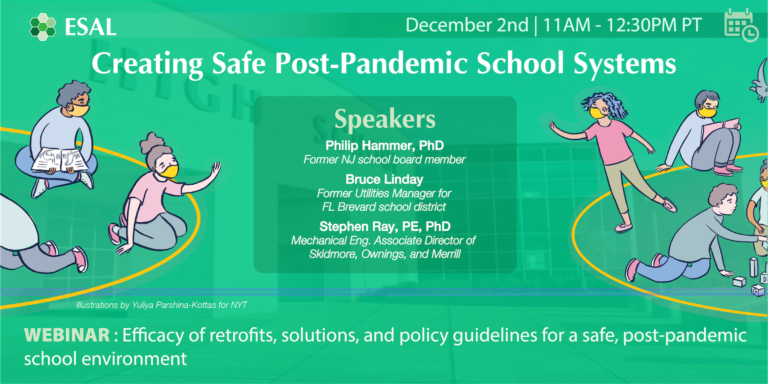
While school children have, for the most part, been spared from the devastating health effects of the coronavirus, they have suffered in other ways -- namely, from the inability to learn in a physical classroom and missing vital interaction with teachers and peers. To address this issue, ESAL and the Architectural Engineering Institute co-hosted a virtual event on December 2 that featured three panelists with expertise in building systems and school governance. The event was moderated by ESAL volunteer Rosemond Ho, who led a thorough discussion on risk management, engineering solutions, and practical considerations for reopening schools.
Two of the panelists, Bruce Lindsay and Stephen Ray, are both professional engineers who have been heavily involved in the American Society of Heating, Refrigerating, and Air-Conditioning Engineers (ASHRAE) -- the leading industry organization which has developed indoor ventilation guidelines for reducing virus transmission. The third panelist Philip “Bo” Hammer brought his perspective as a physicist, parent, and two-term school board member from Haddon Heights, NJ. (Read more about Bo Hammer in his interview with ESAL.)
To reopen safely, “the key is to remove the virus through filters or to dilute the virus through outside air,” explained Lindsay. Lindsay is an energy and resource conservation manager for Brevard County public schools in Florida and serves on ASHRAE’s Epidemic Task Force. The minimum filter type required to provide basic filtration of the virus is known as a MERV 13.
According to Lindsay, the most comprehensive solution would be to bring in an engineering professional to assess a school’s HVAC system, which can be complex and vary widely. Some HVAC systems only filter outside air. Others recirculate indoor air and mix in supply air from the outside. Many old buildings from the early 1900s have no active ventilation at all.
Furthermore, school districts are typically cash-strapped and the timeline for making meaningful upgrades to infrastructure would take years, well beyond the timeline of even this pandemic. Running the HVAC continuously is also impractical due to drastic increases to operating expenses.
In mild climates, schools have the advantage of being able to achieve adequate ventilation simply by opening the windows. Another option is to use standalone box purifiers, which may offer higher HEPA filtration. New York City, for example, opted to purchase individual air purifiers for each classroom when it reopened its public schools.
Given these complexities, former school board member Hammer helped focus the discussion towards low-cost, low tech solutions that can be implemented right now. Hammer’s pragmatism was driven by his past experience in carrying out major school renovations and the challenges associated with such a feat.
Ray, a mechanical engineer by training, emphasized the need for a layered approach that involves more than just technical solutions. Ray leads a high performance design team at Skidmore, Owings & Merrill in Chicago, while also volunteering on ASHRAE committees and on the health advisory team for his children’s schools. He emphasized that administrative controls, which can be highly effective yet inexpensive, should be prioritized: “Even if you can’t revamp your entire HVAC system, you can do tons of things to mitigate the primary mode of [virus] transmission.” This includes checking people’s temperature at the entrance, enforcing masks, keeping students in separate cohorts, installing shields, scheduling, and social distancing.
To drive home the message, Ray recommended a whitepaper written by Taylor Engineering, a nationally recognized firm in building systems and design. Their paper explains that expensive HVAC upgrades cannot be the sole solution and in fact, can be less impactful compared to behavioral measures such as distancing and mask wearing.
At the very least, the pandemic has brought indoor air quality into the realm of conversation for school districts. Infrastructure improvements can create post-pandemic benefits by reducing mold, mildew, and other viruses and bacteria to ultimately enhance student wellness and learning in the future.
The challenges of in-person schooling are not ending anytime soon. Going into 2021, the panelists had this advice to offer engineers and scientists and those involved in school reopenings: “Stay vigilant” and “start making noise,” said Hammer. He explained that getting involved in your community during these tough times can be an empowering and healthy thing to do.
Ray hopes that school districts will maintain clear communication among different constituent groups such as staff, teachers, parents, and students, who must all buy in to reopening plans. Energy manager Lindsay also pointed out that smaller rural districts will struggle to invest in safety measures. He hopes volunteers with technical chops can help out less-resourced schools. And he hopes that public schools will continue to prioritize the neediest groups, especially low income students and kids with special needs.
A recording of this event can be found here.
To access ASHRAE’s guidelines regarding COVID-19, please visit www.ashrae.org/covid. ASHRAE’s virtual national conference will be held on February 9 - 11, 2021. Your local ASHRAE chapter is also a great resource if you are interested in learning more.